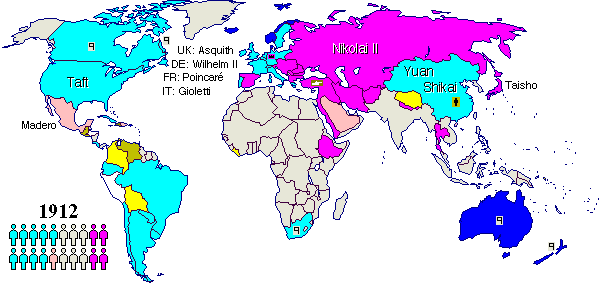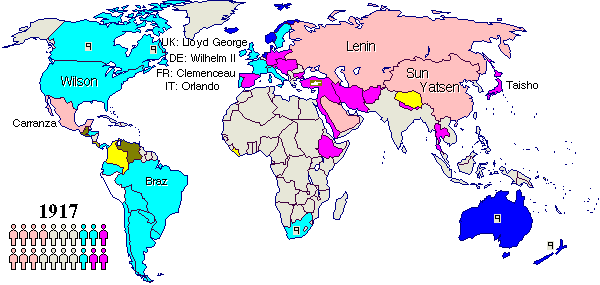



![]()
![]()
The old world order was shattered during this decade. First, the king of Portugual fell in 1910. Then the Emperor of China -- a living god to a quarter of humanity throughout the whole of recorded history -- was overthrown in 1911-12 and replaced by quasi-democratic coalition of intellectuals under the presidency of ambitious general.
Then the assassination of the Crown Prince of Austria-Hungary launched the whole of Europe into the First World War -- a burning landfill of a war into which the great powers shoveled more and more resources until the empty shells of their empires collapsed in exhaustion. By the time the war and its sequels fizzled out and the smoke cleared, the world had lost four more of its most powerful monarchies: Russia in 1917, Germany and Austria in 1918 and Turkey in 1923. Eastward from the Rhine, all the way to the South China Sea, the old world had been swept away.
Toward the decade's end, it was not certain what the new map of the world would look like. Some countries had been temporarily overrun in the First World War: Belgium, Serbia, Montenegro and Romania fell to the Central Powers, while Greece was occupied by the Allies. In the Carribean, four countries (Cuba, Haiti, the Dominican Republic and Nicaraugua) intermitently lost their sovereignty as the United States asserted its roll as the (policeman? bully? caretaker? loan shark?) of the Western Hemisphere. Around the rims of Russia, Austria and Turkey, oppressed nationalities declared their independence.
Despite the mayhem of the decade, by 1912 democracy (of one sort or another) had become the dominant form of government among the world's sovereign nations, a position it would continue to hold for the next 20 years.
![]()
Last updated March 2000.
Copyright © 1998-2000 Matthew White